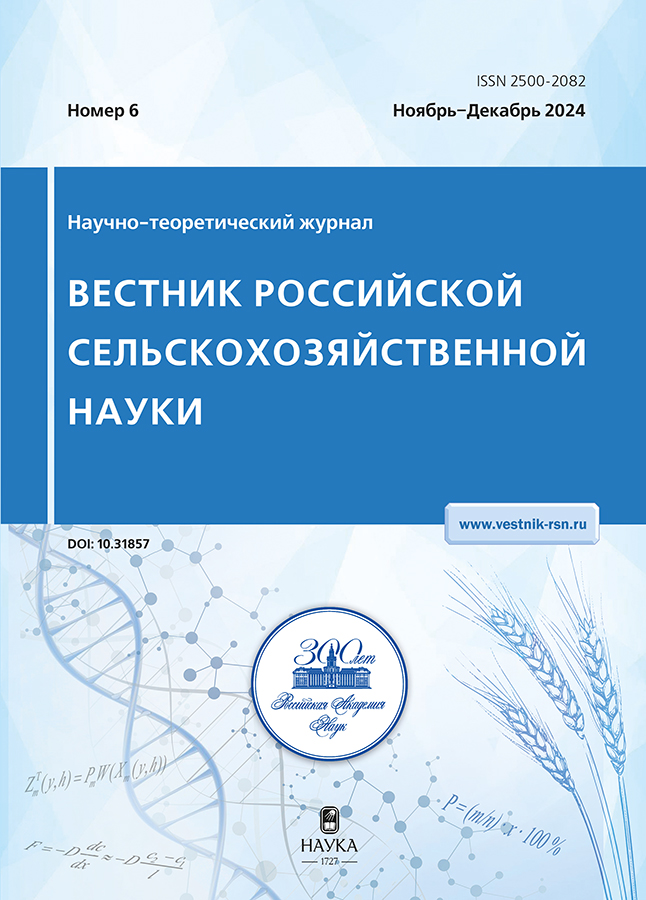Influence of primary soil cultivation methods and systems on the dynamics of humus in drained soil
- 作者: Mitrofanov Y.I.1
-
隶属关系:
- FRC V.V. Dokuchaev Soil Science Institute
- 期: 编号 6 (2024)
- 页面: 66-72
- 栏目: Farming
- URL: https://archivog.com/2500-2082/article/view/659228
- DOI: https://doi.org/10.31857/S2500208224060155
- EDN: https://elibrary.ru/WTBAGZ
- ID: 659228
如何引用文章
详细
The research was carried out on the experimental fields of the All-Russian Research Institute of Reclaimed Lands (Tver Region). The purpose of the research is to study the influence of soil cultivation techniques and systems on the dynamics of humus in drained soil. The soils of the experimental plots are cultivated sod-podzolic, light loamy, gleyic, formed on a moraine or thin binomial. In 5 experiments in crop rotations, methods of minimizing and deepening the arable layer were studied (plowing and moldless loosening at 28–32 cm, three-tier plowing at 40–45 cm), agro-reclamation methods (reclamation loosening at 50–60 cm, volumetric slitting at a depth of 45–50 cm, ridge plowing at 20–22 cm), agro-reclamation and mixed-depth soil cultivation systems. It has been established that soil cultivation techniques and systems are an important factor influencing the speed and direction of changes in humus content in the soil. Their influence was determined, first of all, by the method, depth and frequency of tillage in crop rotation. Positive results on the dynamics of humus were obtained with ridge, combined and minimal tillage systems with volumetric slicing of the soil. Compared with traditional ridge tillage technology, the humus content in the arable layer increased by 0.23% over 7 years, with combined tillage – by 0.37 and minimum – by 0.46%. In soils on carbonated moraine, positive changes in the dynamics of humus were observed when plowing with a plow with cut-out bodies and during reclamation loosening of the soil. In conditions of complex soil cover, on soils formed on thin soil and moraine, the use of reclamation loosening caused additional difficulties in the formation of a deficit-free balance of organic matter. Reclamation loosening of such soils should be accompanied by liming and an increase in the application rates of organic fertilizers per hectare of crop rotation area, compared to the recommended ones.
全文:
作者简介
Yu. Mitrofanov
FRC V.V. Dokuchaev Soil Science Institute
编辑信件的主要联系方式.
Email: 2016vniimz-noo@list.ru
PhD in Agricultural Sciences
俄罗斯联邦, Moscow参考
- Baybekov R.F., Kirpichnikov N.A., Bizhan S.P., Belek A.N. Vliyaniye dlitel'nogo primeneniya udobreniy na pokazateli plodorodiya dernovopodzolistoy pochvy v zernotravyanom sevooborote // Zemledeliye. 2021. № 7. S. 12–15. https://doi.org/10.24412/0044-3913-2021-7-12-15
- Borin A.A., Loshchinina A.E. Produktivnost' sevooborota i plodorodiye pochvy pri razlichnykh tekhnologiyakh yeyo obrabotki // Plodorodiye. 2015. № 2 (83). S. 25–27.
- Dubovik D.V., Chuyan O.G. Kachestvo sel'skokhozyaystvennykh kul'tur v zavisimosti ot agrotekhnicheskikh priyemov i klimaticheskikh usloviy // Zemledeliye. 2018. № 2. S. 9–13. https://doi.org/10.24411/0044-3913-2018-10202
- Kiryushin V.I. Sostoyaniye i problemy razvitiya adaptivno-landshaftnogo zemledeliya // Zemledeliye. 2021. № 2. S. 3–7. https://doi.org/10.244/0044-3913-2021-10201
- Kiryushin V.I. Sistema nauchno-innovatsionnogo obespecheniya tekhnologiy adaptivno-landshaftnogo zemledeliya // Zemledeliye. 2022. № 2. S. 3–7. https://doi.org/10.24412/0044-3913-2022-2-3-7
- Mitrofanov Yu.I. Grebnistaya obrabotka pochvy pod zernofurazhnyye kul’tury // Melioratsiya i vodnoye khozyaystvo // 2011. № 4. S. 14–17.
- Mitrofanov Yu.I. Agrofizicheskiye osnovy povysheniya produktivnosti osushayemykh pochv: Monografiya. Izd-vo: LAP (Lambert Academic Publishing), Gmbh & Co. KG, Heinish-BocKing – Str. Saarbrucken, Deutschland. 2017. 196 s.
- Mitrofanov Yu.I., Gulyayev M.V., Pugacheva L.V., Pervushina N.K. Novyy sposob shchelevaniya osushayemykh pochv // Mezhdunarodnyy sel’skokhozyaystvennyy zhurnal. 2022. 5 (389). C. 541–545. https://doi.org/10.55186/25876740_2022_65_5_541
- Nemchenko V.V., Volynkina O.V., Deryabin V.P. Sistemy obrabotki pochvy i yeye plodorodiye // Agrokhimicheskiy vestnik. 2022. № 3. S. 86–96. https://doi.org/ 10.24412/1029-2551-2022-3-016
- Novoselov S.I., Kuz’minykh A.N., Yeremeyev R.V. Plodorodiye pochvy i produktivnost’ sel’skokhozyaystvennykh kul’tur v zavisimosti ot osnovnoy obrabotki i sevooborota // Plodorodiye. 2019. № 6 (111). S. 22–25. https://doi.org/10.25680/S19948603.2019.111.06
- Perfil’yev N.V., V’yushina O.A. Elementy plodorodiya i produktivnost’ pashni v zavisimosti ot obrabotki pochvy // Sibirskiy vestnik sel’skokhozyaystvennoy nauki. 2020. T. 50. № 1. S. 5–12. https://doi.org/ 10.26898/0370-8799-2020-1-1
- Purgin D.V., Usenko V.I., Kravchenko V.I. i dr. Formirovaniye zasorennosti posevov v zernoparovom sevooborote v zavisimosti ot sposoba obrabotki pochvy i primeneniya sredstv khimizatsii. Zemledeliye. 2019. № 8. S. 8–13. https://doi.org/ 10.24411/0044-3913-2019-10802
- Tyutyunov S.I., Solntsev P.I., Khoroshilova Yu.V. i dr. Vliyaniye priyemov osnovnoy obrabotki pochvy, udobreniy i sredstv zashchity rasteniy na produktivnost’ ozimoy pshenitsy // Dostizheniya nauki i tekhniki APK. 2020. T. 34. № 5. S. 18–23. https://doi.org/10.24411/0235-2451-2020-10503
- Tsygutkin A.S., Azarov A.V. Izucheniye vliyaniya tekhnologiy vozdelyvaniya sel’skokhozyaystvennykh kul’tur i pochvy, kak samorazvivayushcheysya sistemy, na soderzhaniye gumusa // Dostizheniya nauki i tekhniki APK. 2021. T. 35. № 6. S. 44–49. https://doi.org/10.24411/0235-2451-2021-10608
- Shevchenko V.A., Solov’yev A.M., Buber A.L. Vliyaniye priyemov obrabotki pochvy na agrofizicheskiye pokazateli plodorodiya pri vozdelyvanii yachmenya na meliorirovannykh zemlyakh Verkhnevolzh’ya // Plodorodiye. 2018. № 4 (103). S. 40–43.
补充文件













